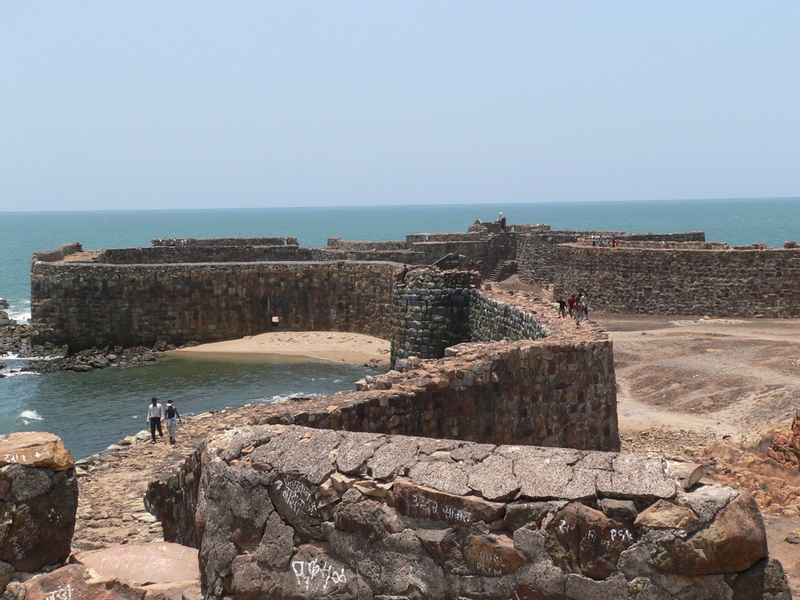Nestled gracefully along the azure shores of the Arabian Sea, Sindhudurg Fort stands as a living testament to maritime history, architectural brilliance, and the coastal beauty of Maharashtra. This magnificent sea fort has not only guarded the Konkan coast for centuries but also beckoned adventurers, history buffs, and those looking to immerse themselves in the history and splendor of the sea.
History of Sindhudurg Fort:
Sindhudurg Fort, meaning “Fort in the Sea,” was commissioned by Chhatrapati Shivaji Maharaj in 1664. This historic endeavor aimed to bolster maritime defenses along the Konkan coast. The fort was strategically constructed on the island of Kurte, near the Malvan town. Over the centuries, it played a pivotal role in various maritime battles and has remained a symbol of the Maratha naval power.
Architecture and Structures:
The architectural marvel of Sindhudurg Fort is a testament to the engineering prowess of its time. Constructed entirely from locally sourced laterite stone and lead, it is renowned for its innovative design. The fort comprises an intricate network of bastions, a prominent citadel with a temple, freshwater reservoirs, and a well-preserved secret passage. Its robust walls, measuring 48 feet high and 12 feet thick, withstand the relentless onslaught of sea waves.
Cultural and Historical Significance:
Beyond its historical value, Sindhudurg Fort holds cultural significance as a representation of Chhatrapati Shivaji Maharaj’s vision and determination. It has become an icon of maritime heritage, celebrating the Maratha spirit. The temple dedicated to the deity Bhavani within the fort adds a spiritual dimension to its historical importance.
Visitor Information:
Reaching Sindhudurg Fort involves a short boat ride from the coastal town of Malvan, which is well-connected to major cities in Maharashtra. The fort is open year-round, and visitors are required to pay a nominal entry fee to explore its treasures.
Best Time to Visit:
The ideal time to visit Sindhudurg Fort is during the post-monsoon and winter months, from October to March. The weather is pleasant, and the sea remains calm, facilitating boat rides to the fort. This period also allows you to explore the fort’s historical riches comfortably.
Nearby Attractions:
The vicinity of Sindhudurg Fort offers a plethora of attractions. The pristine beaches of Malvan, the serene Tarkarli Beach, and the Sargeshwar Shiva Temple are popular places to explore. Snorkeling and scuba diving activities are also available for water sports enthusiasts.
FAQs (Frequently Asked Questions):
1. How do I reach Sindhudurg Fort?
Sindhudurg Fort is accessible by a short boat ride from Malvan. Malvan is well-connected to major cities in Maharashtra.
2. Is there an entry fee to visit Sindhudurg Fort?
Yes, there is a nominal entry fee for visitors to explore the fort.
3. Can I take a guided tour of the fort?
Yes, guided tours of Sindhudurg Fort are available. Knowledgeable guides provide insights into the fort’s history and architecture.
4. Are there any water sports or activities available near Sindhudurg Fort?
Yes, the coastal region around Sindhudurg Fort offers water sports like snorkeling and scuba diving, allowing visitors to explore the underwater beauty of the Arabian Sea.
5. What are the nearby attractions to explore along with Sindhudurg Fort?
Nearby attractions include the beautiful beaches of Malvan, Tarkarli Beach, Sargeshwar Shiva Temple, and various water sports activities.
Conclusion:
Sindhudurg Fort invites you to embark on a captivating journey through maritime history, architectural splendor, and the mesmerizing coastal landscapes of Maharashtra. It is more than just a fort; it’s a living testament to the vision and valor of Chhatrapati Shivaji Maharaj and the enduring legacy of the Maratha maritime prowess. As you traverse its historic walls and experience the gentle caress of the Arabian Sea, you are not just visiting a historical site; you are becoming part of a timeless narrative of courage, ingenuity, and the enchantment of Maharashtra’s coastal heritage.
Featured Image – https://en.wikipedia.org/
